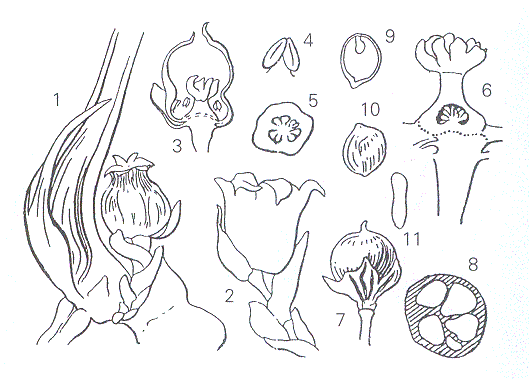..
Aspidistra attenuata
| Accepted name | Aspidistra attenuata B. Hayata. Ic. Pl. Formosan. 2. 145 (1912). The World Checklist of Monocotyledons lists Aspidistra elatior var. attenuata (B. Hayata) S .S. Ying, in Fl. Taiwan, ed. 2, 5: 40 (2000) as the accepted name but I disagree as discussed below. |
| Synonyms | Aspidistra elatior Blume var. attenuata (B. Hayata) S. S. Ying. Fl. Taiwan, ed. 2, 5: 40 (2000). |
| Distribution | Taiwan |
| Description | Description from Flora of China [unedited]. Rhizome: terete, thickened, ca. 1 cm thick, usually covered with scales. Leaves: solitary; petiole 30 - 40 cm; leaf blade oblanceolate, 45 - 50 x 7 - 10 cm. Scape: erect, 3 - 5 cm; bracts 3 - 5. Flower solitary. Perianth: tubular-campanulate, 2 - 2.5 cm, 7- or 8-lobed apically; lobes reflexed, speckled with black, ovatedeltoid, 7 - 8 mm. Stamens: 7 or 8, inserted at middle of perianth tube, subsessile; anthers narrowly oblong, ca. 2.5 mm. Pistil: 4 - 5 mm; ovary broadly conical, ca. 2 mm; style ca. 2 mm; stigma peltate, large. Fruit: berry green, globose, 2 - 2.5 cm in diameter. Season: flowers June; fruits June. 2n = 36 Description of BSWJ 377 (from personal observation of BSWJ 377). INCOMPLETE Rhizome: creeping, terete, diameter ca. 1 cm. Leaves: solitary, well spaced on rhizome, to ca. 125 cm long; cataphylls green, purple-flushed at tip and adjacent to hyaline margin, tip abruptly apiculate usually asymmetrically split ca. [ ] cm; petiole 30 - 40 cm; leaf blade oblanceolate, 45 - 50 cm long x 7 - 10 cm wide. Peduncle: erect, 3 - 5 cm long with 3 - 5 bracts; flowers solitary but freely and often densely produced. Perianth [Perigone]: tubular-campanulate, 2.5 cm long x 2 cm wide, yellow flushed reddish externally and purple-red internally, lobes (7 -) 8, reflexed, [ovate-deltoid, 7 - 8 mm.] Stamens: (7 -) 8, inserted at base of perianth tube, subsessile; anthers narrowly oblong, ca. 2.5 mm. Pistil: bowl-shaped, 4 - 5 mm; style greenish basally , ca. 2 mm, stigma large, filling the perigone tube, 5 mm long x 1.5 cm diameter, ivory-coloured, appearing cross-shaped when viewed from above but bowl-shaped from the side, comprising 4 thin-walled lobes, where the lobes meet the walls increasingly callused towards the centre [the functional stigmatic surface?]; ovary broadly conical, ca. 2 mm; Fruit: undescribed (not seen) Phenology: flowers October - January. 2n = ? |
| References | Tillich 2005 : 331, Hayata 1912, Ying 2000. |
|
Comments
|
Aspidistra attenuata is native to the mountains of Taiwan occurring at up to 2,000 m. My material is propagated from a Crûg
Farm collection (BSWJ 377) from near Tungpu, a mountain resort at 1,200 m in west-central Taiwan. My problem here is that I am not completely certain that BSWJ 377
really is A. attenuata. There are images of A. attenuata at the Taiwan Endemic Species Research Institute at
http://nature.tesri.gov.tw/tesriusr/internet/natshow.cfm?IDNo=542
that shows an apparently completely different plant to BSWJ 377. The Taiwanese Aspidistra (Aspidistra attenuata, Aspidistra
daibuensis and Aspidistra mushaensis) are so poorly defined in the literature that it is not possible to identify plants
with confidence. Tillich's brief description of Aspidistra attenuata (from his 2005 key) is "Stigma campanulate. Perigone lobes 5 – 6, upright. Leaves up to 1.25 m long, lamina 80 × 8 cm." This description does not match BSWJ 377. The bowl-shaped "stigma" of BSWJ 377 is really not campanulate. Also BSWJ 377 has 8 perigone lobes i.e. it is 4-merous and not 3-merous like the plant described by Tillich. Aspidistra attenuata was originally described in 1912 by Bunzô Hayata. Hayata's image of Aspidistra attenuata (reproduced below) is at http://www.biodiversitylibrary.org/page/1159122 and his text is at http://www.biodiversitylibrary.org/page/1172451. Hayata seemed not to have very good material available to him. He was not, for example, able to state the colour of the flowers and his drawings seem to indicate that the flowers he had were dry and rather shrivelled.
Hayata's description of the plant was thus inevitably compromised. Similarly, when Hayata described Aspidistra attenuata as being "nearest to A. elatior" this was perhaps merely in relation to the other Chinese species then known, A. lurida, A. punctata and A. typica which are comparatively small plants. Hayata's comment on the supposed nearness of Aspidistra elatior and Aspidistra attenuata
together with his less than complete description led S. S. Ying in the 2000 Flora of Taiwan edition 2 (5 : 40 - 41) to reduce Aspidistra attenuata to a subspecies of A. elatior.
Ying writes that A. elatior var. attenuata differs from var. elatior only by its narrower attenuate leaves and somewhat different floral characters".
However, if the plant I know as Aspidistra attenuata (BSWJ 377) is correctly labelled (see images) the floral characters are not "somewhat different" they are completely different.
Ying's entry on Aspidistra elatior var. attenuata from the 2000 Flora of Taiwan is here
http://140.112.8.38/tai2/sites/default/files/flora/flora5/pdf/Flora_2_V-0040.pdf
and here
http://140.112.8.38/tai2/sites/default/files/flora/flora5/pdf/Flora_2_V-0041.pdf |
home
top next
last updated 22/10/2008
